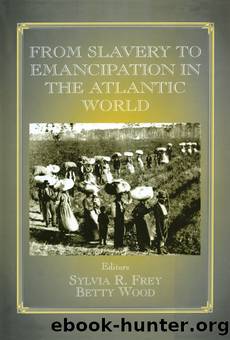From Slavery to Emancipation in the Atlantic World by Sylvia R. Frey Betty Wood

Author:Sylvia R. Frey, Betty Wood [Sylvia R. Frey, Betty Wood]
Language: eng
Format: epub
ISBN: 9780714680255
Barnesnoble:
Publisher: Taylor & Francis
Published: 1999-05-31T00:00:00+00:00
Source: Collection of the New York Historical Society.
At the same time, the continuing mobilizations of an emerging post-emancipation labourersâ movement projected intriguing contrasts in the nature of the public images of men and women rural workers. Male authority, whether in the militaristic manner of a marching company or the disciplined control of a quasi-parliamentary âjustice committeeâ, gained in symbolic representation as some forms of womenâs authority faded from view. The symbolism of a post-emancipation harvest celebration photographed on a cotton plantation outside Mount Pleasant, South Carolina, suggests something of the changing representations of the various men and women who mounted these rural movements. Photographed in the fall of 1874 or 1875 by a photographer who had travelled with Ulysses Grantâs Army of the Mississippi, the composition of the single-file procession of 27 people, at least four of whom are adults, probably reflects the input of both the subjects and the photographer.45 On the one hand, the procession symbolically called attention to workersâ roles in the production of the harvested cotton crop and thereby departed from the intended lessons of plantation rituals that had developed during slavery. Plantation rituals under slavery ceremonialized antebellum plantation power relations by idealizing âMasterâsâ role as provider in the dispensing of plantation allowances or as patriarchal leader of household prayers presiding over a newly Christianized plantation body. By contrast, this post-emancipation harvest observance celebrated the creative power of labouring households, not âMasterâsâ largesse. A lengthy procession of adults, children, and infants winds its way through picked fields, with both women and men bearing large bags of harvested cotton on their heads. An elderly man heading the procession, dressed in what appears to be a battered but serviceable top hat and swallowtail coat, holds aloft a decorative wooden stick, emblematic of a special authority. Another man in the procession also carries some article â either a large book reminiscent of a Bible or a folded banner reminiscent of a federal flag â that also signals his special capacities. By contrast, the most visible women only occupy positions directly behind men who presumably headed their households. Even the oldest woman in the procession, the only woman who carries some kind of non-utilitarian object, perhaps a bell, to suggest her special powers, marches behind the elderly man who leads the procession. The configuration thereby represented hardwon household authority idealized in fairly well-defined patriarchal forms. Significantly, there is scarcely a place for the women workers whose households march in the procession without a male head; their white aprons and bags of cotton are shadowy traces scarcely visible at the rear of the procession. Feminine forms of aggressive militancy essential to some rituals of dissent have scarcely a place in the elements from which harmony and workersâ freedom were represented in this image. The harvest ritual of this plantation community perhaps betrays the impact of a mascuhnization of workersâ social ideals even while their social struggles remained dependent on womenâs efforts.
This search for patterns in ex-slavesâ collective behaviour during and immediately
Download
This site does not store any files on its server. We only index and link to content provided by other sites. Please contact the content providers to delete copyright contents if any and email us, we'll remove relevant links or contents immediately.
| Anthropology | Archaeology |
| Philosophy | Politics & Government |
| Social Sciences | Sociology |
| Women's Studies |
Nudge - Improving Decisions about Health, Wealth, and Happiness by Thaler Sunstein(7255)
iGen by Jean M. Twenge(5166)
The Fire Next Time by James Baldwin(5024)
Adulting by Kelly Williams Brown(4240)
The Hacking of the American Mind by Robert H. Lustig(4092)
The Sports Rules Book by Human Kinetics(4079)
The Ethical Slut by Janet W. Hardy(4042)
Captivate by Vanessa Van Edwards(3732)
Mummy Knew by Lisa James(3522)
In a Sunburned Country by Bill Bryson(3374)
The Worm at the Core by Sheldon Solomon(3327)
Ants Among Elephants by Sujatha Gidla(3282)
Suicide: A Study in Sociology by Emile Durkheim(2908)
The Slow Fix: Solve Problems, Work Smarter, and Live Better In a World Addicted to Speed by Carl Honore(2843)
The 48 laws of power by Robert Greene & Joost Elffers(2817)
Humans of New York by Brandon Stanton(2690)
Handbook of Forensic Sociology and Psychology by Stephen J. Morewitz & Mark L. Goldstein(2605)
The Happy Hooker by Xaviera Hollander(2586)
The Tipping Point by Malcolm Gladwell(2563)
